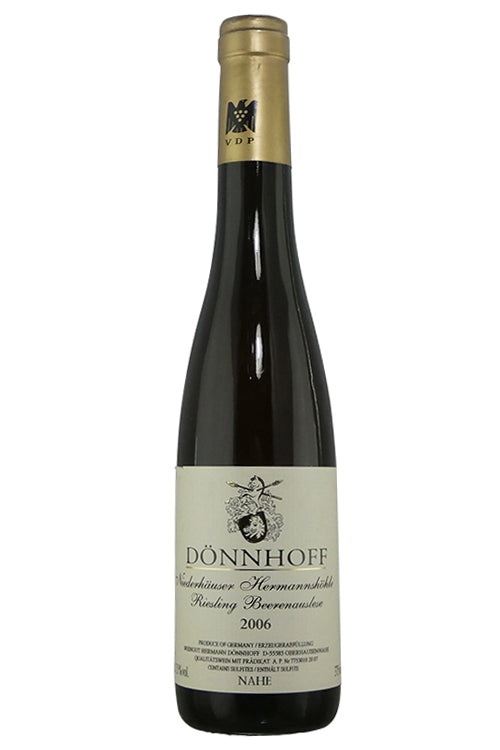1
/
of
1
- Home
- Black Friday Preview - Luxury Wines
- Donnhoff Niederhauser Hermannshohle Riesling Beerenauslese Goldkapsel - 2006 (375ml)
Donnhoff Niederhauser Hermannshohle Riesling Beerenauslese Goldkapsel - 2006 (375ml)
Donnhoff Niederhauser Hermannshohle Riesling Beerenauslese Goldkapsel - 2006 (375ml)
Regular price
$225.99
Sale price
$225.99
Regular price
$259.99
Unit price
/
per
Donnhoff’s 2006 Niederhauser Hermannshohle Riesling Beerenauslese replicates the sort of amazing layering of flavors for which this site is famous, and which this year’s Auslese awesomely displayed. As Donnhoff remarks “even here you can recognize the site, but on a different plane.” But sheer density doesn’t seem to render the layers harder to separate. With its creamy richness comes a remarkable, wafting sense of levity. Honey, pasted nuts and pit fruits, intensely-spiced tropical fruits, and deep, smoky, saline meat and mineral suggestions are accompanied by fluidity, elegance, and an irresistible savor. You can’t ask much more from a nobly sweet Riesling than the complex mystery on exhibit. But it can ask of you that you give it 15-20 years to develop in bottle. It will surely last for at least 50.
“I was amazed when the 2006s tasted as good as I had said they might become,” says Helmut Donnhoff. “It turned out what we vintners always said about Riesling – that’s it’s ideally suited to our clime – is true. I guess I didn’t really didn’t believe that in quite complete seriousness. I ran around the cellar like a crazy man, tasting back and forth” in excitement as the quality of this latest collection became evident. Sample it starting almost anywhere, and you’ll be a believer, too. “If there is one vintage I could compare with this, it would be 1971 as I remember it, with this perfect tension between acid and sugar, this clarity, a bit of botrytis but not stinky, completely clear and mineral, structured, architectural.” In the 21 years I have been visiting him, I have never known Helmut Donnhoff to permit himself such superlatives. “We set the record, harvesting everything in two weeks,” he adds. Trying to handle so many sites needing so much selection in so short a time “was close to the limit, and we managed it only because I have really good people” picking. This year, Donnhoff added to his line-up vineyards in two of the three traditionally top sites of Bad Kreuznach, parcels whose purchase in 2003 he had kept under wraps until now. On the one hand he felt that acquiring parcels another step downstream and in his “home city” and which – like those in Norheim – had once been proudly maintained by “wine nobility” but more recently neglected, followed a theme and closed a circle. “I see myself in the line of cellar-masters who were my mentors. If I didn’t do it,” he says, “there was nobody else left.” On the other hand, he had in mind that vineyards “not quite so close to my heart,” but still top quality (“because a lousy vineyard and a good vineyard take the same amount of work”) could be employed to increase volumes of his generic Riesling. As soon as he tasted the first young wines, he knew they were not destined for blending away! In virtually any other vintage, his top 2006 Auslesen would have been Beerenauslesen, Donnhoff points out, and I have to admit I wondered whether the wines that followed – even if considered virtual Trockenbeerenauslesen – could represent an ascent. “One sees the botrytis during the harvest and one senses the possibilities. But one also knows what can happen if bad weather comes. And all of the vineyards were ripening at the same time. Sweet, dry, botrytized, all were possible at the same time. In principle, I would have had to harvest everything on the same day, which is impossible, crazy. Of course, you could have pushed things to the limit and harvested T.B.A. – I know I can make one at the highest level – but my story, my love is here,” says Donnhoff, stretching his hands over the bottles of Spatlese and Auslese lined up on the table.” That represents my dream, and anything that jeopardizes it must be set aside. I’ll always forgo the extra 10% of opulence.” Hence, although at one point a start was made on berries for T.B.A., in the end, only two truly botrytis-dominated wines, both Beerenauslesen, were picked.
Whisky Advocate - 99 points
Whisky Advocate - 99 points
Availability:
4 In Stock
$25 Shipping on Orders +$299
Couldn't load pickup availability
Share :

- varietal
- Region
- Sub - Region
- Type
- Reviews
Undervalued and frequently mispronounced it offers a wealth of highly aromatic and diverse styles of white wine. Riesling can vary from bone dry, all the way through to lusciously sweet Beerenauslese (BA) and Trockenbeerenauslese (TBA). Its ability to age and transmit the terroir of the vineyard without losing its individual character places it amongst the most noble and academic of grape varieties. Germany is seen as Riesling's Old World home with the greatest concentration in the Mosel Valley, however, plantings have steadily increased across the border in the region of Alsace, France. Most Alsation Rieslings tend to be on the drier side. Even though some Grand Crus contain more sugar, they are still very refreshing and appetizing, due to a high level of acidity.
NULL
White wine is a wine whose color can be pale-yellow, yellow-green, and yellow-gold colored. The wine is produced from a variety of grape varieties. The flavor and color comes from the juice of the grape and sometimes the skin of the grape as well. Interestingly, not all white wine comes from white grapes. Some select red grapes are used as in Champagne.


